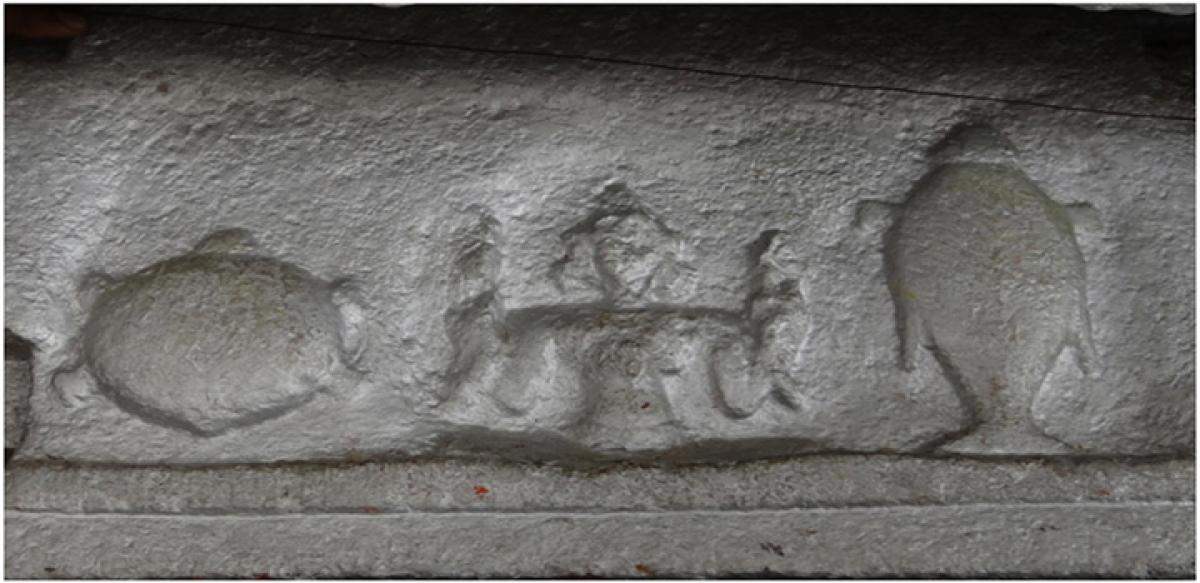Live
- Facial recognition-based attendance in Sectt from today
- TGPSC to be restructured on par with UPSC
- Gabba pitch to have pace and bounce
- Not taking a break after Olympics left me emotionally drained
- SSC public exams from March 17 to 31
- Pathetic state of Zoo Park-Aramghar underpass turning deadly for commuters
- Losses galore for PCB if it pulls out of Champions Trophy over hosting deadlock
- Govt to support plot owners in build homes
- Bumrah maintains No.1; Brook displaces Root
- Karthik’s SA debut: More Indians to join league
Just In

There is a unique sculpture on the door lintel of the main entrance of mahamandapa of Venkateswara Temple situated at Veenavanka of Karimnagar District. It is said to be originally a Jain temple of Badami Chalukya / Rashtrakuta period. This sculpture contains a woman figure, but of a different form in sitting position, flanked by a tortoise on the left and a fish on the right side. The central fig
The unique sculpture at Veenavanka has immense architectural and historical significance and needs to be researched upon
There is a unique sculpture on the door lintel of the main entrance of mahamandapa of Venkateswara Temple situated at Veenavanka of Karimnagar District. It is said to be originally a Jain temple of Badami Chalukya / Rashtrakuta period. This sculpture contains a woman figure, but of a different form in sitting position, flanked by a tortoise on the left and a fish on the right side. The central figure is not having the usual couch (seat) and padma (Lotus).
The bottom of the figure looks like the tail of a bird spread on the curved base. The deity is having some type of ‘ayudhas’ (weapons) in its two hands, which look like the folded wings of a bird. The face and the shape of the head from the front looks like a bird’s head. I had identified it with the family God of Rashtrakutas (8th to 10th centuries) based on the findings of Pandit Bishweshwar Nath Reu in his book, ‘History of the Rashtrakutas’ published by the Archeology department of Jodhpur in 1933.
She is called ‘Latana’ and also known as Rashtrashyena or Manasa Vindyavasini. This goddess took the form of a falcon to save their kingdom. The Rashtrakutas had their rule for some period from Jammuna – Gangetic doab to the southern tip of India. The emblem Tortoise stands for the Yamuna river and the fish for rulers of Pandya country of Southern tip of Indian Sub-continent.
In my opinion, this type of sculpture on the lintel of the main door of a temple is unique and its seems that the facsimile of flag shape was in the minds of sculptors who preferred for permanency of the flag of Rashtrakutas and deviated from the formal type of sculptural composition like a central God sitting on a seat like lotus, flanked by emblems of Ganga, Yammuna or Shanka chakras etc.
There is also another possibility. The Badami Chalukyas and Rashtrakutas were also patrons of Jainism. The central figure may be the Jain’s God, Padmavathi. The emblems, the fish stands for the 7th Jain Tirankara, Suparshwa Nath and the Tortoise stands for the 20th Tirankara, Suvrath Nath.
As this is a unique Archaeological finding. The Government of Telangana must order for thorough research to bring to light the historical greatness of this sculpture. - The writer is a Senior Architect & Former Chairman of The Indian Institute of Architects, AP Chapter

© 2024 Hyderabad Media House Limited/The Hans India. All rights reserved. Powered by hocalwire.com







